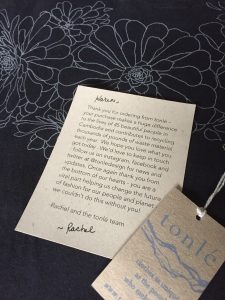My transition into slow everything, food, fashion, fitness, has been, well…slow. My evolution into a conscious consumer a work-in-progress. Good habits take time to cultivate, after all. And it’s not always easy. Improving my health, my carbon footprint, or my writing craft takes effort and a great deal of planning. Oh, the planning! I find I’m no longer the jump right in and get it done sort. The older I get the more planning becomes one of my cornerstones to achieving my goals
Cue my foray into slowing things down and letting go of Fast Fashion. I read a truly alarming statistic the other day in an article discussing the movie: The True Cost. In a conversation with Livia Firth, Founder and Creative Director of Eco-Age, a fashion activist (also the wife of Mr. Darcy, sometimes known as Colin Firth), she mentioned The average garment remains in a person’s closet for an average of five weeks. What!?!
My first thought was the amazing amount of time some people must spend shopping. Yikes! If you’re throwing away clothes at that rate, you must be really like the mall. I’m also wondering about the amount of money being spent. But when you can buy a t-shirt for $4.99, who cares if you throw it out when it falls apart after one wash. So much of what we consume is disposable. Unfortunately, it’s not biodegradable.
Livia Firth is also a force behind the 30 Wear Challenge. When you buy an article of clothing commit to wearing it a minimum of thirty times. I know some of you are already a pro at this concept. But some of you, like me, might want to check out your closet, or take a look in your daughter’s closet. Or at her floor. What about that one-time-wear adorable holiday outfit you bought for your grandchild? Or your dog?
An estimated 1 million tons of textile waste is dumped into landfills around the world each year.
Armed with that tragic stat, I did a little research and learned what I could do to be more conscious about my wardrobe choices and my shopping habits. Enter the words: eco, ethical, and sustainable.
Me? I’m a terrible impulse shopper. So that’s one of the habits I need break. Turns out it’s not that hard to do when you have to keep an ear to those three ideals and the commitment to 30 wears. Shopping then becomes a little overwhelming, to be honest. But not impossible. Hence the planning part and also the realization I have to take it slow. Ease my way towards my end goal of an ethical wardrobe.
Five Ways To Becoming A More Thoughtful, Slower Consumer:
- Buy local.
- Buy less.
- Buy used.
- Buy from independent designers.
- Buy quality garments that last.
My discoveries so far: Miik (A 100% Canadian Company), Tonle (A Zero Waste Fashion Line) and SlumLove Sweater Company (Ethically Handmade in Kenya).
Personally, it’s also about improving the lives of people at the very beginning of the supply chain. The majority of garment workers are women who work and reside in some of the most underdeveloped countries in the world working for factories and brands who have little regard for safety and labour protection issues.

A dress from Tonle, a zero waste fashion line.
Someone complimented me on my Tonle shirt (my new favourite) the other day and after I said thanks I asked if they wanted to hear the story behind my shirt? As a writer and teller of stories, why not wear one?
What’s in your wardrobe?
